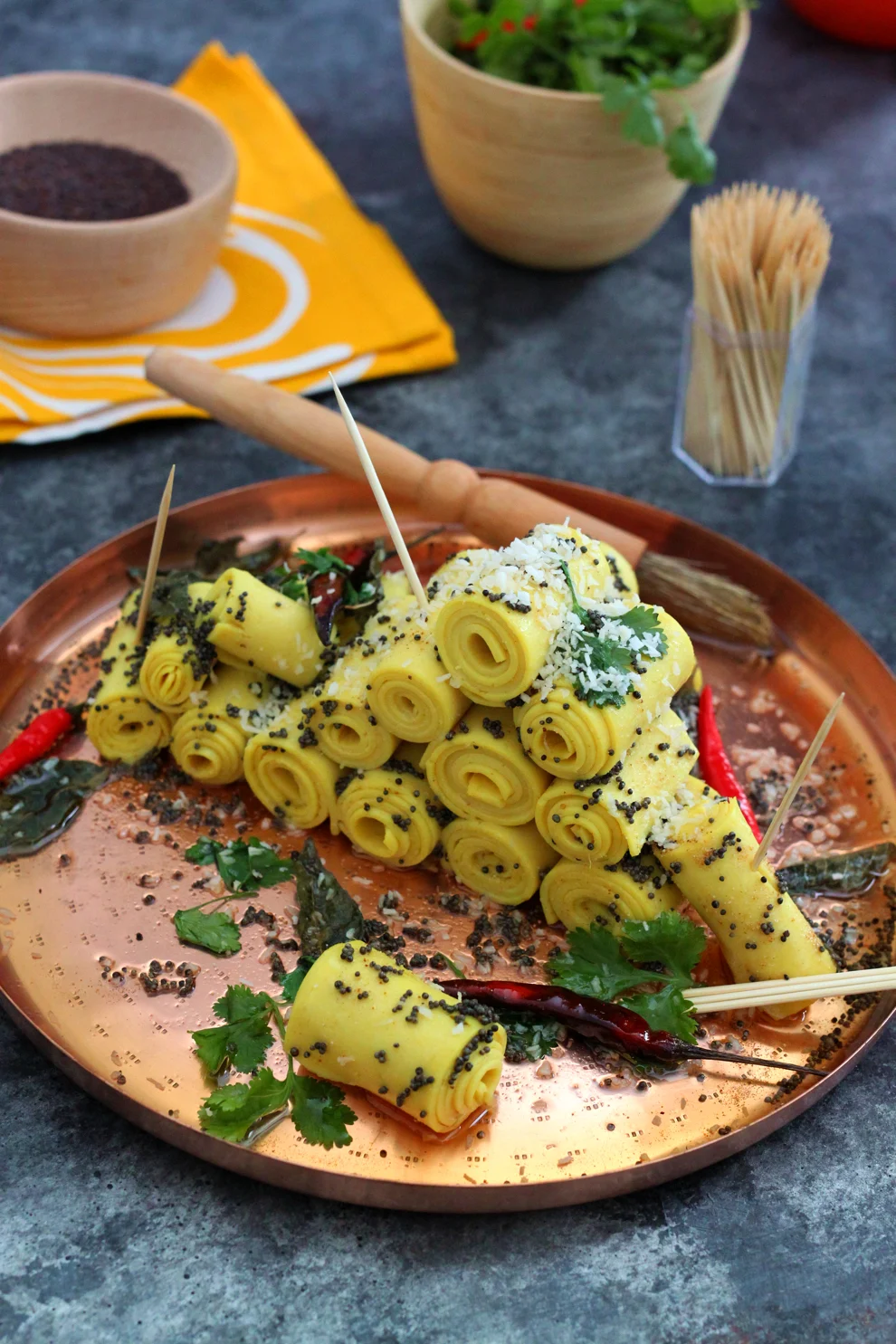Hot, sour, sweet and salty; These are the characteristics of the Gujarati dishes I grew up eating. From spongy Khaman Dhokla, to Sev Tameta nu Shaak, chickpea flour plays an integral role in the make up of regional Gujarati food. It’s used for batters and bhajiya (across India), as the basis for Pudla (chickpea flour pancakes) and as a thickener for soups like the yoghurt-based favourite, Kadhi. One thing all of these dishes have in common is that each one is famous for being hot, sour, sweet and salty.

Introducing Khandvi
Another savoury Gujarati snack that’s known for having these explosive and delicious flavours is Khandvi. It’s a village-style rolled pasta made with chickpea flour and yoghurt (in this case, soy yoghurt) which is always served with a tempering of mustard seeds, curry leaves and chillies crackled in hot oil. The sound and smell of the smoking oil hitting the smooth surface of the pasta rolls gives me all the feels.
The texture is soft, silky and it melts in your mouth, unlike the wheat pasta we’re all so used to. If you’re a pasta lover on the lookout for something a little bit more unusual, you’ve got to try these. Or maybe you remember your grandma making these for you when you were a kid…
I’ve always been fascinated by how food travels. All cultures have their own versions of pasta, bread, rice dishes, dumplings, pancakes and so much more. While Indian street food trends are currently all about Pasta Dosa and Maggi noodles, a brief look back into rich regional cuisines will reveal pasta-like treasures such as these Khandvi rolls, Daal Dhokli, Sev and Gathia. And boy, are they good.
I love Khandvi it because it requires very few ingredients to make and it’s also one of those rare Gujarati Naasto dishes (tea-time snacks) that isn’t fried. As much as I adore Bateta Vada (fried spicy potato balls), I know it’s not a treat I’ll scoff every day. These on the other hand, I’d go for Khandvi any time, any day.

Tips for making perfect khandvi
Here are some things to bear in mind when making Khandvi (grandma style) as well as some new school tips for getting your noodle sheets rolled thinly and evenly.
- Use a blender for a smooth, cohesive Khandvi batter. Lumps aren’t wanted here. Wait, are lumps ever wanted anywhere?
- Cook the Khandvi batter in a non-stick pan, low and slow. It thickens pretty quickly so you want to give yourself time to get those pesky lumps out.
- Use a silicone spatula or whisk to stir when cooking the Khandvi batter.
- Pay close attention to the consistency of the batter. It’s ready when the batter no longer falls off the spatula when lifted and begins to set on the sides of the pan. Think peanut butter consistency. To check if the batter is ready to spread, you can spread a little bit over a steel plate or piece of foil, allow it to set for a few minutes and then see if it rolls up easily. If not, cook it a little longer.
- This one is super important… You need to work quickly! Khandvi batter doesn’t wait around. Once it reaches the right consistency, it must be spread very quickly. It helps to have your foil sheets ready on the work surface before you even start cooking the batter.
- A lot of recipes call for the surface of the foil or thali you’re spreading the batter on to be greased. Do this VERY lightly otherwise the batter is going to slide around and clump up like no man’s business. This will make it impossible to spread.
- To spread the khandvi, I use a silicone spatula. Once it’s spread as evenly as I can get it (and still hot), I cover it with a piece of cling film and then use a rolling pin to roll it as thin as I can get it, about 1-2mm.
- If you have one, use a pizza cutter to slice your set Khandvi – it’s so much easier and neater than trying to use a knife.
- This recipe is for Vegan Khandvi and uses soy yoghurt but the traditional version just uses regular yoghurt.
- Serve the Khandvi at room temperature simply by themselves, with masala chai or your favourite chutney.

Equipment
- Non-stick pan
- Spatula
- Aluminium foil
- Rolling pin
- Whisk
Ingredients
For the vegan khandvi rolls:
- 140 g chickpea flour
- 280 ml cold water
- 285 g soy yoghurt such as Alpro or regular yoghurt for a non-vegan version
- Juice of 2 lemons
- 20 g ginger grated
- 1 1/2 tsp fine salt
- 3 tsp sugar
- 1/4 tsp asafoetida optional - omit for gluten-free Khandvi
- 1/4 tsp ground turmeric
For the tempering:
- 2 tbsp sunflower oil
- 2 tsp mustard seeds
- 10-12 curry leaves
- 2-3 thin chillies pierced
- 2 tbsp fresh or desiccated coconut
- 2 tbsp freshly-chopped coriander leaves
Instructions
To make the khandvi:
- Blend all the ingredients for the khandvi rolls together to make a smooth paste.
- Place two large sheets of aluminium foil on a heat-resistant surface (about 1M long sheets) and grease them with oil VERY lightly.
- Pour the batter mixture into a non-stick pan and cook it over a low flame for 8-10 minutes, until it's the consistency of thick, smooth peanut butter. Keep stirring constantly to stop it from settling at the bottom and creating unwanted lumps. I find the best tool for this is either a silicone whisk or silicone spatula.
- Working very quickly, spread half the batter on top of the first sheet of foil. Spread it thinly and evenly using a silicone spatula. Place a piece of cling film on top. Repeat for the second half of the batter on top of the second piece of foil. Use a rolling pin to roll the dough evenly between the cling film and foil. It should be 1-2mm thick. Allow it to set for 5 minutes.
- Use a pizza cutter or sharp knife, trim away any scrappy, uneven edges (those are for you to enjoy). Slice the Khandvi into long strips, all about the same width. Use your fingers to roll them up tightly. Repeat for all the Khandvi sheets and arrange on to a platter or plate.
For the tempering:
- Heat the oil in a small pan. Add the mustard seeds, curry leaves and chillies and cook until the mustard seeds have finished popping. Pour this over the rolled Khandvi. Garnish with chopped coriander and coconut.
Sanjana's Notes
* Refrigerate in an airtight container for up to 48 hours.



30 Best Ideas Vegan Indian Appetizers - Best Recipes Ideas and Collections
Saturday 6th of February 2021
[…] Best Vegan Indian Appetizers from Vegan Khandvi Indian Chickpea Pasta Rolls. Source Image: www.sanjanafeasts.co.uk. Visit this site for details: www.sanjanafeasts.co.uk […]
Tanuja mistry
Wednesday 20th of November 2019
It’s fair to say I’ve never made a successful batch of khandvi in my life... until I tried your recipe Sanjana! Oh my gosh they are so delicious and we’re a huge hit with my MIL, FIL and their family. They were stunned I made them myself and am sure still think I bought them from outside. Great tips for rolling thinly. Can’t thank u enough!
Shweta
Wednesday 30th of October 2019
Hi. To keep the khandvi batter pliable after cooking you can keep the pan on top of a vessel filled with very hot water. It keeps the batter from cooling. You can also include sesame seeds in the tempering. Sprinkle chili powder before pouring the tempering.